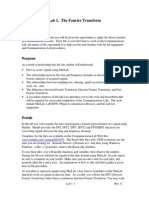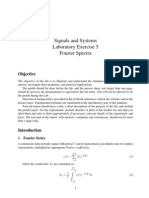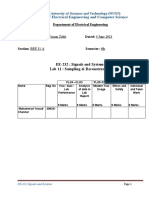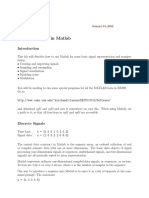Introduction To Matlab
Introduction To Matlab
Uploaded by
msm158Copyright:
Available Formats
Introduction To Matlab
Introduction To Matlab
Uploaded by
msm158Original Title
Copyright
Available Formats
Share this document
Did you find this document useful?
Is this content inappropriate?
Copyright:
Available Formats
Introduction To Matlab
Introduction To Matlab
Uploaded by
msm158Copyright:
Available Formats
SIGNALS AND SYSTEMS LABORATORY 1: Introduction to Matlab INTRODUCTION In this lab, you will learn the basic and
intermediate functions of MATLAB and apply them to the theory of Convolution and Fourier Transforms. MATLAB is a high-level language and interactive environment that enables you to perform computationally intensive tasks faster than with traditional programming languages. Our objectives in this lab are to 1. Understand MATLAB We will be using the tutorial provided by Mathworks. The following website will provide the tutorial material. http://www.mathworks.com/academia/student_center/tutorials a. Creating Variable in Matlab b. Performing Calculation c. Visualizing Data d. Creating Scripts with Matlab 2. Gain Experience with MATLAB tools a. Convolution i. Write a convolution program ii. Use CONV b. Low-pass filter i. Voice signal ii. ECG signal
Page 1 of 3
SIGNALS AND SYSTEMS LABORATORY 1: Introduction to Matlab Gain Experience with MATLAB tools
Assignments will be collected in Lab #2. Work in group is allowed.
Experiment #1:
Linear Convolution
Given a pair of sequences, use discrete convolution to find the response to the input x[n] of the linear time-invariant system with impulse response h[n]. x[n]= square wave with amplitude 1 y[n]= triangle wave with amplitude 2 i. Use PLOT command to plot the input and impulse response ii. Compute the convolution by hand, use MATLAB to plot the results iii. Write a MATLAB function to compute the convolution of the two finite-length sequences and plot the results. For length N input vector x, the DFT is a length N vector X, with elements N X(k) = sum x(n)*exp(-j*2*pi*(k-1)*(n-1)/N), 1 <= k <= N. n=1
iv. Use CONV command to verify the results from b).
Experiment #2:
Low-pass Filters
Part 1: In this section of the tutorial, you will create a signal with added high frequency noise. Later in the tutorial, you will use a low-pass filter to eliminate high frequency noise.
1. Type load mtlb 2. You can hear a voice say "MATLAB." This is the signal to which you will add noise soundsc(mtlb,Fs) 3. Create a noise signal
Page 2 of 3
4. 5.
6. 7.
noise = cos(2*pi*3*Fs/8*(0:length(mtlb)-1)/Fs)'; (You can hear the noise signal by typing soundsc(noise,Fs)) (You can also use random function to introduce noise) Add the noise to the original signal u = mtlb + noise; Scale the signal with noise u = u/max(abs(u)); (You scale the signal to try to avoid overflows later on. You can hear the scaled signal with noise by typing soundsc(u,Fs)) Display the frequency spectrum using FFT (experiment 2) View the scaled signal with noise specgram(u,256,Fs);colorbar (In the spectrogram, you can see the noise signal as a horizontal line at about 2800 Hz, which is equal to 3*Fs/8)
8. Use low-pass filters to eliminate high frequency b = ones(1,10)/10; % 10 point averaging filter fy = filtfilt(b,1,x); % Noncausal filtering fyy = filter(b,1,x); % Normal filtering 9. Use FFT to plot the power spectrum of the filter signal and compare it to both, the original and the corrupted signals. Part 2: Real World Practical Application In this section of the tutorial, you will be provided an ECG ( Electrocardiogram) signal with noise. Your task is to create a matlab program to determine the frequency of the noise and eliminate the noise signal.
Page 3 of 3
You might also like
- Statement of PurposeDocument1 pageStatement of Purposerohaanmumtaz100% (1)
- Laboratory 3 Digital Filter DesignDocument8 pagesLaboratory 3 Digital Filter DesignModitha LakshanNo ratings yet
- Simulation of Digital Communication Systems Using MatlabFrom EverandSimulation of Digital Communication Systems Using MatlabRating: 3.5 out of 5 stars3.5/5 (22)
- Digital Signal Processing: Lab ManualDocument13 pagesDigital Signal Processing: Lab ManualUbaid Ur RahmanNo ratings yet
- Lab 1. The Fourier Transform: WWW - Utdallas.edu/ kamran/EE4250Document10 pagesLab 1. The Fourier Transform: WWW - Utdallas.edu/ kamran/EE4250sklansNo ratings yet
- Elt316 2011 Lab3Document13 pagesElt316 2011 Lab3Courtley AlbertNo ratings yet
- Digital Signal Processing - Exercises: 1 Sequences and SystemsDocument7 pagesDigital Signal Processing - Exercises: 1 Sequences and SystemsAsia YasirNo ratings yet
- Laboratories ELG 3125A Fall 2017: School of Electrical Engineering and Computer ScienceDocument29 pagesLaboratories ELG 3125A Fall 2017: School of Electrical Engineering and Computer ScienceLIGHTNo ratings yet
- ADC LabsDocument19 pagesADC LabsJAVED AKHTAR REG.2020 UET NFC FD ELECT 76.No ratings yet
- Lab 02: An Experiment With Tuning Fork Synthesis of SinusoidalDocument6 pagesLab 02: An Experiment With Tuning Fork Synthesis of Sinusoidal100a100aNo ratings yet
- Lab 4Document8 pagesLab 4majjjiNo ratings yet
- Comp Eng 4Tl4 - Digital Signal Processing Lab #2: Implementation and Analysis of Discrete-Time SystemsDocument3 pagesComp Eng 4Tl4 - Digital Signal Processing Lab #2: Implementation and Analysis of Discrete-Time SystemsAlvaroNo ratings yet
- Lab 03Document7 pagesLab 03Pitchaya Myotan EsNo ratings yet
- Filters I - Study of System Response: Experiment 2Document5 pagesFilters I - Study of System Response: Experiment 2ue06037No ratings yet
- Digital Signal Processing LABDocument10 pagesDigital Signal Processing LABNimra NoorNo ratings yet
- DSP LAB File 20bec095Document19 pagesDSP LAB File 20bec095GOURAV MAHORENo ratings yet
- Files-7-Lab ManualsDocument50 pagesFiles-7-Lab ManualsnannurahNo ratings yet
- Signals in MatLab PDFDocument18 pagesSignals in MatLab PDFPratik SarkarNo ratings yet
- Lab 3. Digital Filters - Real Time DSP Lab ManualDocument6 pagesLab 3. Digital Filters - Real Time DSP Lab ManualHamayunNo ratings yet
- M 14109Document4 pagesM 14109Nhân Nguyễn ĐăngNo ratings yet
- Program/ Demo Execution Viva-Voce Record Total 10 30 30 10 10 10 100Document3 pagesProgram/ Demo Execution Viva-Voce Record Total 10 30 30 10 10 10 100Sathiya MurthiNo ratings yet
- Matlab Ss SolnDocument7 pagesMatlab Ss Solncheenu15No ratings yet
- Exp 1Document2 pagesExp 1Hariharan RavichandranNo ratings yet
- Lab ExperimentDocument14 pagesLab ExperimentRashid KhurshidNo ratings yet
- Experiment 2: Fourier Series and Fourier Transform: I. ObjectivesDocument8 pagesExperiment 2: Fourier Series and Fourier Transform: I. ObjectivesJomarCalacagNo ratings yet
- Lab 4 Acoustic Direction Finder: Ecen 487 Real-Time Digital Signal Processing LaboratoryDocument6 pagesLab 4 Acoustic Direction Finder: Ecen 487 Real-Time Digital Signal Processing Laboratoryscribd1235207No ratings yet
- EEE - 321: Signals and Systems Lab Assignment 1Document7 pagesEEE - 321: Signals and Systems Lab Assignment 1Atakan YiğitNo ratings yet
- Fourier LabDocument6 pagesFourier LabAzeem IqbalNo ratings yet
- EE370 Lab Experiment 01Document6 pagesEE370 Lab Experiment 01Ayman YounisNo ratings yet
- Lab 03 F 01Document8 pagesLab 03 F 01sabi1234No ratings yet
- EE370 Lab Experiment 07Document3 pagesEE370 Lab Experiment 07Mustaq AhmedNo ratings yet
- DSPLab8 ReportDocument14 pagesDSPLab8 ReportMuhammad AliNo ratings yet
- Lab01 Introduction To MatlabDocument7 pagesLab01 Introduction To MatlabSeyed SadeghNo ratings yet
- DSP Lab RecordDocument37 pagesDSP Lab RecordSathvick BatchuNo ratings yet
- Lab4: Sampling and Quantization of Audio Signal in MatlabDocument9 pagesLab4: Sampling and Quantization of Audio Signal in MatlabRabail InKredibl100% (1)
- EE370 Lab ManualDocument62 pagesEE370 Lab ManualReymond CeriloNo ratings yet
- Lab 11 - Muhammad Yousuf (306331)Document15 pagesLab 11 - Muhammad Yousuf (306331)Saif UllahNo ratings yet
- LAB 5 Filtering Periodic Signals PDFDocument5 pagesLAB 5 Filtering Periodic Signals PDFSon TranNo ratings yet
- Fir and I I R Filters Worksheet AnswersDocument9 pagesFir and I I R Filters Worksheet AnswersNoedjoem Kaboer AerNo ratings yet
- Lab1FA11 PDFDocument11 pagesLab1FA11 PDFaxecaleverNo ratings yet
- Assign W6Document4 pagesAssign W6joez2flyNo ratings yet
- EE301 IIT Kanpur Course Instructor: Dr. Naren Naik Assignment - 1 (22 January 2019)Document2 pagesEE301 IIT Kanpur Course Instructor: Dr. Naren Naik Assignment - 1 (22 January 2019)nithishNo ratings yet
- Technological University of The Philippines: ManilaDocument19 pagesTechnological University of The Philippines: ManilaLea SantosNo ratings yet
- DSP Lab ManualDocument57 pagesDSP Lab ManualRabia SamadNo ratings yet
- Sampling Lab5Document10 pagesSampling Lab5Mengistu AberaNo ratings yet
- 24.378 Signal Processing I Laboratory 2: U (T-A), HDocument2 pages24.378 Signal Processing I Laboratory 2: U (T-A), HRodrigoNo ratings yet
- DSP Lab 2Document7 pagesDSP Lab 2hung kungNo ratings yet
- Digital Signal Processing Lab Manual: Subject Code: ECE 3161Document45 pagesDigital Signal Processing Lab Manual: Subject Code: ECE 3161Basudha PalNo ratings yet
- Time Domain and Frequency Domain Signal Representation: ES440. Lab 1-MATLABDocument3 pagesTime Domain and Frequency Domain Signal Representation: ES440. Lab 1-MATLABRajendrakumar KumarNo ratings yet
- DSPlab 1&2Document13 pagesDSPlab 1&2shreyadhanbhar23No ratings yet
- Lab 4Document8 pagesLab 4hamzaNo ratings yet
- LAB 4 Fourier Series PDFDocument5 pagesLAB 4 Fourier Series PDFSon TranNo ratings yet
- 7 SS Lab ManualDocument34 pages7 SS Lab ManualELECTRONICS COMMUNICATION ENGINEERING BRANCHNo ratings yet
- Lab 3Document8 pagesLab 3Jafar HussainNo ratings yet
- Tugas UTS MatlabDocument18 pagesTugas UTS MatlabSatria Rumpin WongsoSenjoyoNo ratings yet
- Speaker Recognition ReportDocument13 pagesSpeaker Recognition ReportAlberto Sánchez RuizNo ratings yet
- Some Case Studies on Signal, Audio and Image Processing Using MatlabFrom EverandSome Case Studies on Signal, Audio and Image Processing Using MatlabNo ratings yet
- Digital and Kalman Filtering: An Introduction to Discrete-Time Filtering and Optimum Linear Estimation, Second EditionFrom EverandDigital and Kalman Filtering: An Introduction to Discrete-Time Filtering and Optimum Linear Estimation, Second EditionNo ratings yet
- Ali Zahid: +92 315 200 6002 Alizahid0 Alizahid Alizahid3Document1 pageAli Zahid: +92 315 200 6002 Alizahid0 Alizahid Alizahid3msm158No ratings yet
- Mini Project Spring 2014Document1 pageMini Project Spring 2014msm158No ratings yet
- Control ModellingDocument7 pagesControl Modellingmsm158No ratings yet
- Control SystemDocument16 pagesControl Systemmsm158No ratings yet
- 8.discrete Probability DistributionDocument25 pages8.discrete Probability DistributionAbror md FayiazNo ratings yet
- Newton's Interpolation Methods: P. Sam JohnsonDocument47 pagesNewton's Interpolation Methods: P. Sam Johnsonحمامة السلامNo ratings yet
- 1 L-Shaped Steiner Routing AlgorithmDocument9 pages1 L-Shaped Steiner Routing AlgorithmgnikunjNo ratings yet
- Signal Flow DiagramsDocument20 pagesSignal Flow DiagramsSingappuliNo ratings yet
- OLS AssumptionsDocument40 pagesOLS AssumptionsAbhimanyu VermaNo ratings yet
- Speech Enhancement Using Minimum Mean-Square Error Short-Time Spectral Amplitude EstimatorDocument13 pagesSpeech Enhancement Using Minimum Mean-Square Error Short-Time Spectral Amplitude EstimatorwittyofficerNo ratings yet
- Structural Analysis A Unified Classical and Matrix ApproachDocument866 pagesStructural Analysis A Unified Classical and Matrix ApproachHariHaranNo ratings yet
- Machine Learning Super Cheatsheet (Prof. Pedram Jahangiry)Document2 pagesMachine Learning Super Cheatsheet (Prof. Pedram Jahangiry)Adan Nicolas Vasquez SmithNo ratings yet
- CS350-CH01 - Data Structures and AlgorithmsDocument34 pagesCS350-CH01 - Data Structures and AlgorithmsprafullsinghNo ratings yet
- 15 - PracticeC (4) - JupyterLabDocument4 pages15 - PracticeC (4) - JupyterLabbhuvinarkhedeNo ratings yet
- Lab 5 Introduction To Simulink and Filter Design Using MATLAB.Document26 pagesLab 5 Introduction To Simulink and Filter Design Using MATLAB.sgegorovNo ratings yet
- Reportproject Groupe5Document13 pagesReportproject Groupe5faaruuqdabaqNo ratings yet
- 2.9. Items Arrive at A Machine Shop in A Deterministic Fashion at A Rate of One Per Minute. EachDocument4 pages2.9. Items Arrive at A Machine Shop in A Deterministic Fashion at A Rate of One Per Minute. EachAlbert GeraldiNo ratings yet
- Flat (Complete Notes)Document91 pagesFlat (Complete Notes)varshitapericherla24No ratings yet
- 1.1 The Nature of Time Series DataDocument19 pages1.1 The Nature of Time Series DataTrịnh TâmNo ratings yet
- Quantitative Analysis Technical TermsDocument4 pagesQuantitative Analysis Technical TermsMaireen Jamie BalibalosNo ratings yet
- Quiz 1 - Econometrics 2Document8 pagesQuiz 1 - Econometrics 2ahmed tahirNo ratings yet
- Midterm Exam: Eastern UniversityDocument13 pagesMidterm Exam: Eastern UniversityJannatul FerdaousNo ratings yet
- Week 2 Practice QuizDocument6 pagesWeek 2 Practice QuizManukushal DMNo ratings yet
- Problem CH 3Document3 pagesProblem CH 3upb553118No ratings yet
- MTMD Flexible StructuresDocument5 pagesMTMD Flexible StructuresSandipan DharNo ratings yet
- Mat575 2009-1Document5 pagesMat575 2009-1Wan FazrinNo ratings yet
- Diwali Assignment Unit-1 20BAI10214Document9 pagesDiwali Assignment Unit-1 20BAI10214KshitizNo ratings yet
- Feedback Control SystemDocument11 pagesFeedback Control SystemRam Nice100% (2)
- Fault Detection and Correction: STLD Case StudyDocument8 pagesFault Detection and Correction: STLD Case StudyAvinash BishtNo ratings yet
- Projectile Motion Longer DerivationDocument2 pagesProjectile Motion Longer DerivationDanial KhanNo ratings yet
- 3 ARIMA Models - 3.1 Autoregressive Moving Average ModelsDocument37 pages3 ARIMA Models - 3.1 Autoregressive Moving Average ModelsTrịnh TâmNo ratings yet



























































































